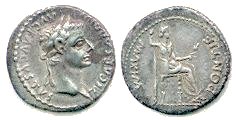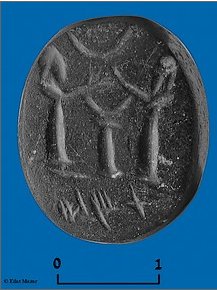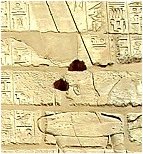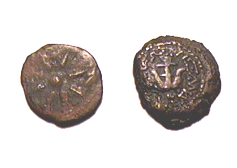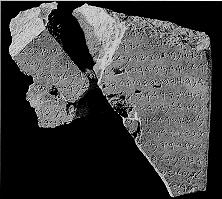- Return to BibleProbe
- Discussion Board
|
|||
| (MARK 12:15-17)
Shall we give, or shall we not give? But he, knowing their
hypocrisy, said unto them, "Why
tempt ye me? bring me a penny, that I may see it."
And they brought it. And he saith unto them, "Whose
is this image and superscription?"
And they said unto him, Caesar's. And Jesus answering said unto
them, "Render to Caesar the things
that are Caesar's, and to God the things that are God's."
And they marveled at him. |
|
First Temple Seal
|
A stone
seal bearing the name of one of the families who acted as servants
in the First Temple and then returned to Jerusalem after being
exiled to Babylonia has been uncovered in an archeological
excavation in Jerusalem's City of David, a prominent Israeli
archeologist said on January 16, 2008. The 2,500-year-old black stone seal, which has the name "Temech" engraved on it, was found in January 2008 amid stratified debris in the excavation under way just outside the Old City walls near the Dung Gate, said archeologist Dr. Eilat Mazar, who is leading the dig. According to the Book of Nehemiah, the Temech family were servants of the First Temple and were sent into exile to Babylon following its destruction by the Babylonians in 586 BCE. The family was among those who later returned to Jerusalem, the Bible recounts
|
|||
|
False claim - Jesus'
Ossuary found in Jerusalem in 1980
|
The story starts in 1980
in Jerusalem’s Talpiot
neighborhood, with the discovery of a 2,000 year
old cave containing ten coffins. Six of the ten
coffins were carved with inscriptions reading
the names: Jesua son of Joseph, Mary, Mary,
Matthew, Jofa (Joseph, identified as Jesus’
brother), Judah son of Jesua (Jesus’ son - the
filmmakers claim). Professor Amos
Kloner, who had published the findings of his research in
the Israeli periodical Atigot in 1996, told Deutsche
Presse-Agentur dpa.
|
|||
| Archaeologists find evidence of "Goliath" in earliest Philistine artifacts | Nov 2005: Archaeologists digging at
the purported biblical home of Goliath have unearthed a shard of
pottery bearing an inscription of the Philistine's name, a find they
claim lends historical credence to the Bible's tale of David's
battle with Goliath. |
|||
The
Exodus did Happen - Chariot wheels and bones found in the Red Sea |
Picture left is of a 4-spoke Chariot wheel among several found by divers in the Red Sea. Click link left to see more, including inscriptions in rock found all over the Sinai area. | |||
Did
Ramses III take the Ark? Was Ramses III the Bibles' "Shishak"?
|
Mike Sanders, who runs
"BibleMysteries.com"
is a biblical scholar, researcher, and investigator of the first
order. Mike looks to the Bible for the tough questions and he
just may be onto something here. Just perhaps the Ancient Jews
knew Ramses III, the Pharaoh of Egypt as "Shishak" who was
mentioned above as the king who attacked Judah and went off with all
its treasures.
Mike has traced "Shishak" down all over the middle east and has created an exciting VHS video where you can watch him stand in front of a stone relief depicting Ramses III carrying off treasures from Judah (showing a golden "box" on two golden poles). Mike went even further and found an ancient building which Shikshak (Ramses III) could have built as a Temple to honor his god(s) for his defeat of the Jews. This building is in the West Bank town of Djahiriya. Now, just what if something is buried under the cornerstone there. See how far Mike was allowed to go. His other video where he travels to the bottom of the Dead Sea looking for Sodom and Gomorrah is also an eye opener. Both reasonably priced VHS videos are of the very best quality, and a must if you are interested in Bible Archeology.
|
|||
| New Temple Mount Furor - News | "Everyone who was here
- the representatives of the government, the State Attorney's
Office, the Jerusalem Municipality, the court itself - knows that
there is a tragedy and a terrible crime taking place on the Temple
Mount." In September 2001 there is a complaint from the
Iranians that Israel is digging two tunnels under the Temple Mount.
Also, see Iranian Wakf stopped from
excavations at the southern wall of the Temple Mount |
|||
|
During the night Pharaoh summoned Moses and Aaron and
said, "Up! Leave my people, you and the Israelites! |
|||
| Joseph in Eqypt - 7 good & 7 bad years | We dwelt
in this castle seven years of good life--how difficult for memory
its description! Then came years barren and burnt up: when one evil
year had passed away, Then came another to succeed it. |
|||
|
Tour
Hazor at this Israeli site. Hazor
is the largest biblical-era site in Israel, covering some 200 acres.
The population of Hazor in the second millennium BCE is estimated to
have been about 20,000, making it the largest and most important
city in the entire region. Its size and strategic location on the
route connecting Egypt and Babylon made it "the head of all
those
|
|||
| Sinai Inscription-Miriam's Rebellion against Moses | Small
part reads: "Miriam, Prophetess of lying lips and deceitful
tongue. She causes the tribes to conspire against the pillar and
prince of the people. |
|||
| Sinai Inscription - Miraculous Provision of Water | Sinai Inscription describes
God's miraculous provision of water in the Sinai--by God commanding
Moses to miraculously cause pure water to flow from a rock. |
|||
| Tower of Babel (ancient Bablylon) | Modern
day Tower of Babel ruins (on the outskirts of ancient
Babylon-current day Iraq) are currently 150 feet above the plain
with a circumference of 2300 feet. |
|||
|
"And
a river went out of Eden to water the garden; and from thence it was
parted, and became into four heads. The name of the first is
Pison: that is it which compasseth the whole land of Havilah, where
there is gold; And the gold of that land is good: there is bdellium
and the onyx stone. And the name of the second river is Gihon:
the same is it that compasseth the whole land of Ethiopia. And the
name of the third river is Hiddekel: that is it which goeth toward
the east of Assyria. And the fourth river is Euphrates." Genesis
2:10-14
Click on the left link and visit Bible- Mysteries.com. While there check out the info on Michael Sanders' dive on the mini-sub "Delta" in the Dead Sea, and his search for the Ark of the Covenant.
|
|||
| Where is Mount Sinai? | God's presence on top of
Mt. Sinai supernaturally burned it (Exodus 24:17; Deut. 5:23) --
though the Burning Bush was not burned up (Exodus 3:2-3). Is it at
the traditional St Catherine's site or in Arabia at Jabal al Lawz?
Others think Not! |
|||
| Proof of Israel outside the Bible in 1200 BC | There is
a short section at the end of the poem describing a campaign to
Canaan by Merneptah in the first few years of his reign around 1210
BC. One line mentions Israel: "Israel is laid waste, its seed
is not." |
|||
| Inscriptions in the Catacombs | More than 30,000 Greek and
Latin inscriptions have been
discovered in the catacombs, and this number accounts only for the
excavations completed to date. |
|||
|
One of the ancient
documents found at Nag Hammadi in 1945. See translated
document here and a link to the history of the 52 text found at Nag
Hammadi. |
|||
| Jericho - The Walls DID Come Tumbling Down! | Three major expeditions to
the site over the past 90 years uncovered abundant evidence to
support the Biblical account," |
|||
| Gold Menorah Now Ready For The Third Temple | The Temple Institute in the
Old City of Jerusalem has now completed the construction of a golden
Menorah, similar to the one used in ancient times in the Holy
Temple. |
|||
| Startling Archeological Discoveries | Can we trust the Bible? The
answer is an overwhelming YES! Grant R. Jeffrey shares some
archeological discoveries that provide tremendous proof that the
Bible is a true and accurate record of past events in ancient
Israel. |
|||
| Jerusalem Tombs | If the Temple Mount is
Heaven, then the valleys around it represent the opposite. The
valleys surrounding Jerusalem's Old City have long been associated
with Hell and the Last Judgment. According to sources in the Bible
and elsewhere, and archaeological finds, the Kidron and Hinnom
Valleys were a busy burying ground. |
|||
| Dead Sea Scrolls - not being analyzed properly? | One unusual Scroll is the
"Copper Scroll," written on thin copper foil, not on
parchment or papyrus as the others were. It contains a strange
inventory, listing huge hoards of gold and other precious items,
worth about $30 million in current value, with 64 hiding places
where they were concealed. Could this refer to a real treasure, or
was it a fable? Christian scholars, unaware of the halachic
background involved, preferred to call the Scroll a fantasy, no such
treasure was ever accumulated. One Polish Catholic priest, Milik, to
whom the Copper Scroll was officially assigned for publication,
fumbled totally in his interpretation, mistranslating the most
elementary terms.
|
|||
| Armed Skeletons Confirm Fall of Nineveh |
At its
height, Nineveh was the center of the Assyrian Empire, which
dominated Mesopotamia and the Near East hundreds of years before the
rise of the Roman Empire.
They lie as they fell more than 2,600 years ago, a writhing clump of humanity frozen in a moment of fearful combat. Pieces of armor, iron daggers, pikes, and other weapons litter the ground. Buried in the desiccated leg bone of one of the soldiers is another emblem of blood and pain: a triple-bladed bronze arrowhead, cunningly shaped to inflict maximum harm. |
|||
Widow's Mite
|
"Now Jesus sat opposite the [temple] treasury and saw how the people put money into the treasury. And many who were rich put in much. Then one poor widow came and put in two mites, which make a quadran. So He called His disciples to Himself and said to them, "Assuredly, I say to you that this poor widow has put in more than all those who have given to the treasury; for they all put in out of their abundance, but she out of her poverty put in all that she had, her whole livelihood." Mark 12:41-44 | |||
| early Proof of the Christian Gospels | The Chester Beatty I
Papyrus (p45) contains all four gospels and Acts.
It was copied 100-150 A.D.. (It was formerly thought to be
late 2nd or early 3rd century A.D.) The Complete Text of the
Earliest New Testament Manuscripts has a photograph showing part
of p45 on p.146. A General Introduction to the Bible p.389
says the original scroll was about 220 leaves, of which we have 30
leaves preserved. On the preserved leaves are:
Matthew (2 leaves) 20:24-32; 21:13-19; 25:41-26:39) Mark (6 leaves) 4:36-5:2; 5:16-26; 5:38-6:3; 6:15-25,36-50; 7:3-15; 7:25-8:1; 8:10-26; 8:34-9:9; 9:18-31; 11:27-12:1; 12:5-8,13-19,24-28 Luke (7 leaves) 6:31-41; 6:45-7:7; 9:26-41; 9:45-10:1; 10:6-22; 10:26-11:1; 11:6-25,28-46; 11:50-12:13; 12:18-37; 12:42-13:1; 13:6-24; 13:29-14:10; 14:17-33 John (2 leaves) 4:51,54; 5:21,24; 10:7-25; 10:30-11:10; 11:18-36,42-57. Acts (13 leaves) The Bodmer II Papyrii (p66) was copied c.175 or c.125-150 A.D.) It originally had 76 leaves (=156 pages) and has page numbers. Today we have preserved 104 leaves and fragments of 40 other leaves. A photograph of John 6:58-64 from the Bodmer II Papyrus is in the New International Dictionary of the Bible p.1003. It contains: John 1:1-6:11, 6:35b-14:26,29-30; 15:2-26; 16:2-4; 16:6-7; 16:10-20:20; 20:22-23; 20:25-21:9; 21:12,17 (fragments of John 19:16). Bodmer 14/15 Papyrii (p75) is typically dated 175-200 A.D., or 175-225 A.D. However, its handwriting is very similar to another document, Papyrus Fuad XIX, which is known to have been written 145-146 A.D. P75 originally had 114 leaves, and we have preserved 102 leaves. It has most of Luke and John. (A General Introduction to the Bible p.390) The Complete Text of the Earliest New Testament Manuscripts has a picture of part of it on p.496. Specifically, it has Luke 3:18-22; 3:33-4:2; 4:34-5:10; 5:37-6:4; 6:10-7:32; 7:35-39, 41-43; 7:46-9:2; 9:4-17:15; 17:19-18:18; 22:4-24:53 John 1:1-11:45; 11:48-57; 12:3-13:1; 13:8-9; 14:8-29; 15:7-8 p90 (c.175 A.D.) of John 18:36-19:7
|
|||
| Manna and Quail |
Manna and Quail “So it was that quail came up at evening and covered the camp, and in the morning the dew lay all around the camp. And when the layer of dew lifted, there on the surface of the wilderness, was a small round substance, as fine as frost on the ground.” Exodus 16:14 “And the house of Israel called its name Manna. And it was like white coriander seed, and the taste of it was like wafers made with honey.” Exodus 16:31 Over Five hundred years ago an eyewitness account of manna was written by a Dean from Mainz named Bernard von Breitenbach. Breitenbach made his pilgrimage to the Holy Land in the 15th century, accompanied by the Dominican, Felix Faber. In 1483 he wrote about manna: He said that it “This same Bread of Heaven" he continues "falls about daybreak, like dew or hoarfrost and hangs in beads on grass stones and twigs. It is sweet like honey and sticks to the teeth.” In the early 1920’s Botanical experts, Friedrich Simon Bodenheimer and Oskar Theodor from The Hebrew University at Jerusalem set out for the Sinai Peninsula to clear up the disputed question of manna once and for all. They brought back the first photographs of manna and firmly established the truth of the Biblical story. The Tamarisk trees indigenous to the Sinai are host to a little insect, which exude a peculiar resinous secretion. This secretion is about the same shape and size as a coriander seed. When it falls to the ground it is white in color, but turns to a yellowish brown in a short time. The people from the Hebrew University also said that the taste was like honey. To date the Bedouins of the Sinai gather this manna as early as possible in the morning before the ants come to life. In a good year they can collect four pounds per head. In their yearly immigration from the Coast of West Africa to Spain, quails and other birds fly across the Red Sea. Exhausted by their long flight, they stop on the flat shore to muster strength for the next stage of their journey over the high, mountains to the Mediterranean. Even today the Bedouins in this area catch the exhausted quails by hand in spring and in autumn.
Reference: The Bible as History by Werner Keller
|
|||
|
Clay seal connects to Bible Archaeological find in Jerusalem bears name in Scripture |
October 1, 2008 JERUSALEM It is the most remarkable find since excavations in the heart of this 3,000-year-old capital of ancient Israel began 140 years ago: a tiny clay seal impression also known as a bulla or stamp, discovered near the ruins of what has been identified as King David's palace and bearing the name of an influential courtier mentioned in the Hebrew Bible. "It is not very often that archaeologists have surprises that bring them so close to the reality of the biblical text," said Eilat Mazar, whose pinpoint dig in a relatively small site this summer led her to a clay bulla whose ancient Hebrew script identifies its owner as Gedalyahu ben Pashhur. Speaking to an enthusiastic audience of 1,500 Israelis who converged on the Palestinian-Arab Silwan quarter, known as Kfar Hashiloah, or Siloam in the Bible, Mrs. Mazar said, "One could not have asked anything more than this." AVI OHAYON/SPECIAL TO THE WASHINGTON TIMES Excavations at the City of David site, just outside the walls of the Old City of Jerusalem, have yielded seal impressions that date back 2,600 years, when the city was besieged by the Babylonians, and at least two from ministers under King Zedekiah. Ben Pashhur's name is cited in the Book of Jeremiah 38:1 together with that of Yehuchal ben Shelemayahu, whose bulla was discovered at the same site two years ago. The two were ministers in the court of King Zedekiah, the last king from the Davidic dynasty to reign in Jerusalem. His reign, from 597 to 586 B.C., ended with the Babylonians' destruction of the First Temple on nearby Mount Moriah. Finish reading this at: WashingtonTimes
|
|||
|
The "House of David" stele &
"Moab Stone"
|
Now in the Israel Museum is
a stele that archeologists turned up on 21 July 1993, with an
inscription referring to the "House of David," This is the first
real evidence that refers to the biblical king. The Tel Dan Stele is
evidence for David being on the throne in that territory which we
typically refer to as Judah. This is known as: The Tel Dan Inscription (a.k.a. The Bytdwd Inscription) (a.k.a. The House of David Inscription) The inscription is by King Hazael of Aram-Damascus in about 825 B.C. It indicated that his father, Hadad II, was victorious in battle against the "foot soldiers, charioteers and horsemen of the King of the House of David" (against Jehosaphat, c. 860 B.C.). |
|||
A second stone, called the "Moabite Stone" was discovered by a German missionary names F. A. Klein in 1868 at Dibon (ancient Moab; present-day Jordan). The inscriptions on this stone recount the rebellion of King Mesha of Moab against King Jehoram of Israel and King Jehosaphat of Judah. Mesha was the king of the Moabites who was forced to pay tribute to his neighbor, the Nation of Israel. The Bible tells us that this tribute suddenly stopped: "Mesha, king of Moab, rebelled against the king of Israel..." (2 Kings 3:5). "And Mesha king of Moab was a sheepmaster,
and rendered unto the king of Israel an hundred thousand lambs, and
an hundred thousand rams, with the wool. But it came to pass, when
Ahab was dead, that the king of Moab rebelled against the king of
Israel." - 2 Kings 3:4-5 It reads: "I Mesha,
king of Moab, made this monument to Chemosh, to commemorate
deliverance from Israel. My father reigned over Moab 30 years, and I
reigned after my father. Omri, king of Israel oppressed Moab many
days, and his son (Ahab) after him. But I made war against the king
of Israel and drove him out, and took his cities, Medeba, Ataroth,
Nebo, and Jahaz, which he built while he waged war against me. I
destroyed his cities, and devoted the spoil to Chemosh, and the
women and girls to Ashtar. I built Qorhah with prisoners from
Israel." |
